MIXARS PRIMO
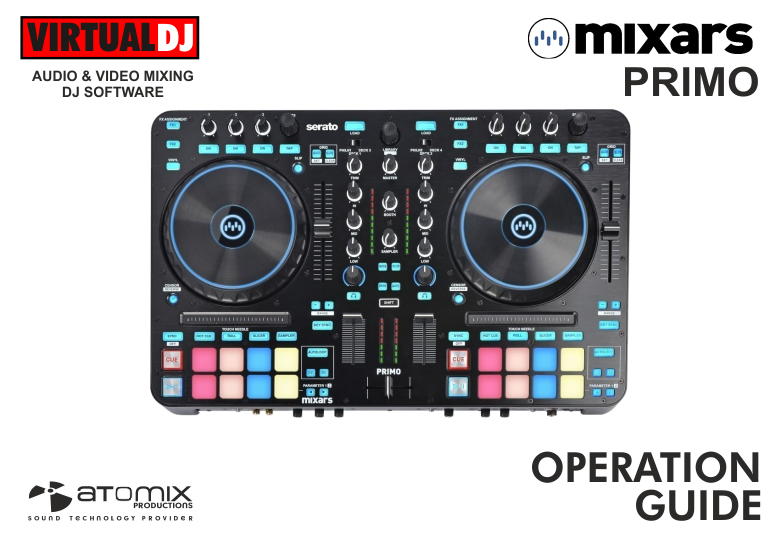
INSTALLATION
Firmware & Drivers
Firmware:
Update the firmware of the unit to the latest version from Mixars website.
Drivers:
Windows users download and install latest drivers from Mixars Primo product page.
MAC OS X users don't need to install any drivers for Mixars Primo to operate.
Download and install VirtualDJ 2020 from our Downloads Page
(in case you have not done already)
Once VirtualDJ 2020 is launched, a Login Window will appear. Please login with your preferred method from the ones provided.
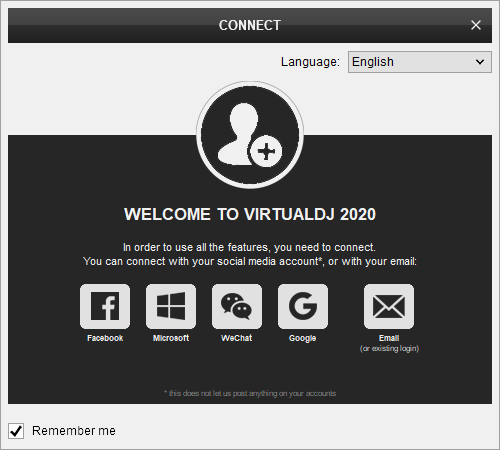
A Pro Infinity, a Pro Subscription or a Mixars Primo Plus License is required to fully use the Mixars Primo.
Without any of the above Licenses, the controller will operate for 10 minutes each time you restart VirtualDJ.
Buy a license
Click on the "Use Soundcard" button for VirtualDJ to apply the predefined audio setup with the built-in sound card of the Mixars Primo. You can still change that from Settings->AUDIO tab.
Click to OK.

Advanced Setup
MIDI Operation
The unit should be visible in the CONTROLLERS tab of Config and the “factory default” should be available/selected from the Mappings drop-down list. The factory default Mapping offers the functions described in this Manual, however those can be adjusted to your needs via VDJ Script actions.
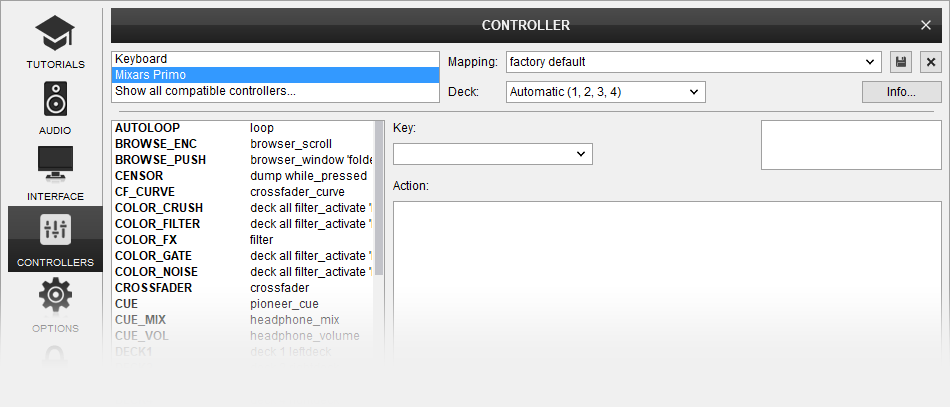
Find more details at VDJ Pedia
AUDIO Setup
The unit has a pre-defined Audio setup and a special button in the AUDIO tab of Config to provide that. Alternative Audio setups can be applied in the same window.
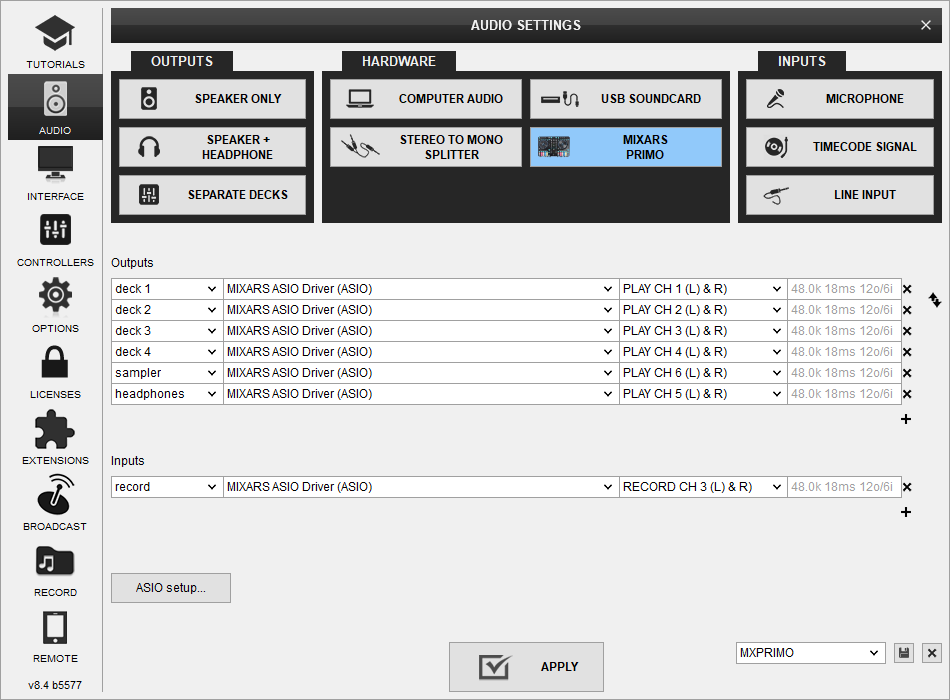
For further software settings please refer to the Manuals of VirtualDJ 2020
LAYOUT
S SHIFT: Hold this button down to access secondary functions of Mixars Primo (mainly in black lettering inside a white box)

The functionality of each button, knob and slider per section (as shown in the image above) will be explained in detail in the next chapters
Mixer & Browser
MIXER CONTROLS

- CROSSFADER. Blends audio between the left and right channels.
- VOLUME. Adjust the Volume of each channel.
- CUE (PFL) (per channel) Press these buttons to send each channel to the Headphones Output channel.
- COLOR FX PARAMETER. Adjust the parameter of the selected COLOR FX for each channel. When in middle position, the COLOR FX has no effect on the sound.
- LOW EQ. Adjust the Low frequencies for each mixer channel.
- MID EQ. Adjust the Mid frequencies for each mixer channel.
- HI EQ. Adjust the High frequencies for each mixer channel.
- TRIM. Adjust the Gain of each mixer channel.
- INPUT SELECTORS. Define the source of each Channel. Put the switchers to Deck 1/Deck 3 (for left side) or Deck 2/Deck 4 (for right side) position for software mixing.
- MASTER VOLUME. Adjust the level of the Master Output.
- BOOTH MONITOR. Adjust the level of the Booth Output.
- SAMPLER VOLUME. Adjust the Master Output Volume of the VirtualDJ Sampler
- CH INPUT VUMETER. Shows each channels input (pre fader) volume
- MASTER OUTPUT VUMETER. Shows the master output volume of the unit.
- SOUND COLOR FX. Select one of the predefined Color Effects (Noise, Filter, Echo and Crush).
Please note that the available Color Effects are offered by Mixars Primo Firmware and you cannot change/alter them through VirtualDJ (Hardware Effects)
- S SHIFT. Press and hold this button to access secondary functions (black lettering in white box) of other controls on Mixars Primo
BROWSER CONTROLS
- BROWSE:
Turn: Scrolls through files or folders.
Push: Change the focus of the browser between Songs and Folders lists.
While focus is on Folders list hold down SHIFT and press the knob down to open/close the subfolders of the selected folder. - LOAD: Press this button to load the selected track on the corresponding deck.
Press this button fast twice (double click) to clone the song from the other deck.
Hold down SHIFT and press this button to unload the deck.
Deck Controls
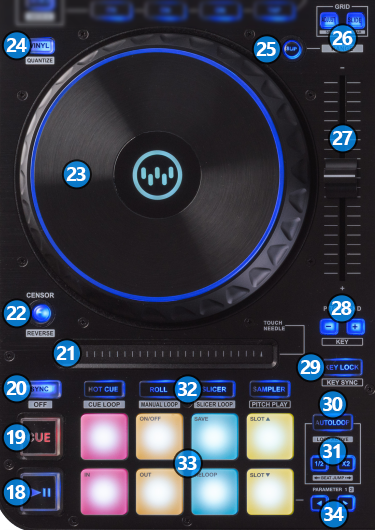
- PLAY/PAUSE: Plays / Pauses the track. Press and hold SHIFT and then press this button to "stutter-play" the track from the last set Cue Point.
- CUE: When the Deck is paused, you can set a temporary Cue Point by moving the Platter to place the Audio Pointer at the desired location and then pressing the Cue Button. During playback, you can press the Cue Button to return the track to this Cue Point. (If you did not set a Cue Point, then it will return to the beginning of the track.). If the Deck is paused, you can press and hold the Cue Button to play the track from the Temporary Cue Point. Releasing the Cue Button will return the track to the temporary Cue Point and pause it. To continue playback without returning to the Temporary Cue Point, press and hold the Cue Button, then press and hold the Play Button, and then release both buttons.
Hold down SHIFT and then press this button to return to the beginning of the track. - SYNC: Press this button to automatically match the corresponding Deck's tempo with the opposite Deck's (or the Master Deck’s if using a 4 decks Skin) tempo and phase.
Hold down SHIFT and press this button to manually select this deck as the Master Deck.
Hold down SHIFT and hold this button down for 1 sec to resume automatic selection of the Master Deck. - NEEDLE SEARCH STRIP: The length of this strip represents the length of the entire track. Place your finger on a point along this sensor to jump to that point in the track (song position).
Important notice: In order to avoid accidental track jumps the needle search does not operate when the deck is on air. If you want to use the strip while a deck is on air please hold down SHIFT first, and then touch the strip. - CENSOR: Press and hold this button to play the track backwards. On release the track will continue from the position it would have been if the button was never pressed. Hold down SHIFT and press this button (momentarily) to play the track backwards. Press again to return to forward direction.
- JOGWHEEL: Touch sensitive platter for scratching (Vinyl Mode), bending (CD Mode) or Grid adjusting.
The outer blue leds will rotate according to the software jogwheel position, and will blink near the track's end as a warning that the track ends.
The logo leds will light with the currently selected deck's color in order to allow a quick visual identification of the current decks layers. - VINYL: Press this button to toggle the jogwheel between the Scratch and Bend modes.
Hold down SHIFT and press this button on the left side of the controller to toggle Quantize on/off for all decks. When Quantize is enabled, setting loops, jumping between hot cue points and starting playback of the deck will snap to the grid (CBG) of the track.
Hold down SHIFT and press this button on the right side of the controller to switch between the available sideview windows.
Hold down SHIFT and hold this button down on the right side of the controller for 1 sec to open/close the sideview window. - SLIP: Enables Slip Mode. Several software functions (such as Jogwheel movements, HotCues and Loops) will apply temporary on the track, and the track will return to the position it would have been if those functions were not triggered.
Hold down SHIFT and press this button to cycle through the available pitch ranges. - GRID ADJUST/SLIDE:
Adjust: Hold down this button and then move the JOGWHEEL to adjust the width of the CBG of the track (equal to adjusting the BPM of the track).
Hold down SHIFT and press this button to set the current track's position as the starting position of the CBG (beat 0)
Slide: Hold down this button and then move the JOGWHEEL to shift the position of the CBG of the track.
Hold down SHIFT and press this button to reanalyze the track for BPM and thus reset any manual changes you have made. - TEMPO: Controls the track's playback tempo.
- PITCH BEND: Press these buttons to temporarily decrease (button -) or increase (button +) the playback tempo of the track. When you release the buttons the playback tempo will reset to the value designated by tempo slider (27)
Hold down SHIFT and press these buttons to decrease (button -) or increase (button +) the musical key of the track (tonal shifting) - KEY LOCK: Press this button to "lock" the track's pitch to its current value. The track's tempo will remain at the speed designated by the tempo slider (27). Further adjustments of track's playback speed will not alter the track's key.
Hold down SHIFT and press this button once to make the key of the track compatible with key of the other deck (or the master deck if using 4 decks skin).
Attention: The key will become compatible with that of the other deck only if a change of +/-1 semitone is required.
Hold down SHIFT and press this button again to reset the key back to it's original value (if the key has been altered) - AUTOLOOP: Sets an Automatic loop where it's length equals the current loop length as seen in VirtualDj GUI. You can use the Loop Half/Double (31) buttons to adjust the length of the auto loop.
Hold down SHIFT and press this button to reactivate the last used loop. - LOOP HALF/DOUBLE: Halves/Doubles the size of the current active loop, or the predefined loop length used by Autoloop (30).
Hold down SHIFT and press these buttons to move the loop 1 beat backwards (button Half) or forward (button Double) if a loop is active. If a loop is not active the track will jump playback position instead. - PAD MODES: Switch the pads of the unit to various modes (see PADS)
- PADS: Offer various operations, depending on the PADs Mode (see PADS)
- PARAMETERS: Offer various operations, depending on the PADs Mode (see PADS)
PADS
The 8 Pads offer various functions, depending on the selected Pad mode. Each of the 4 Pad mode buttons offers 2 individual modes. One with the press of the mode button, and an additional mode with press of the mode button while SHIFT is held down. The 8 modes represent a page of the PADS section on the default VirtualDJ GUI.
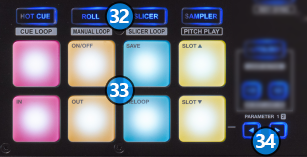
- PAD MODE. Press any of the 4 available Pad mode buttons to set the Pads to Hotcues, Loop Roll, Slicer and Sampler mode.
Hold SHIFT and then press any of the 4 available Pad mode buttons to set the Pads to Cue Loop, Manual Loop, Beatjump and Keycue mode. - PADS. The 8 Pads offer different functionality depending on the selected mode.
- PARAMETERS. Depending on the selected page, these buttons control various parameters of the selected page.
HOTCUES
Press the HOT CUE mode button to set the PADs to Hot Cue mode and automatically load the Hotcues pads page in VirtualDJ GUI
Each one of the 8 pads assigns a Hot Cue Point, or jumps the track to that Hot Cue Point (if assigned).
When a Hot Cue Button is unlit, you can assign a Hot Cue Point by pressing it at the desired point in your track. Once it is assigned, the Hot Cue Button will light on.
Hold SHIFT and then press a pad to delete its assigned Hot Cue Point.
Press the PARAMETERS buttons to jump to previous/next cue point in the track (if it exists)
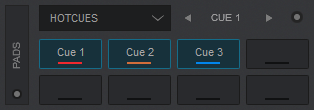
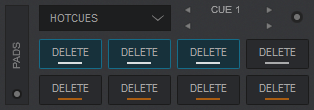
LOOP ROLL
Press one of the 8 pads to trigger a momentary Loop Roll. Once the Pad is released, the track will resume playing from the position it would have been if the Loop Roll was never triggered. The exit point will be visible on the waveform of the VirtualDJ GUI with an additional “running” play marker.
Hold SHIFT to get ½, ¾, 1 and 2 beats Loop Roll sizes for the 4 lower pads.
Use the Page menu to apply the Loop Rolls to Video.
The PARAMETER buttons are not used in this mode.
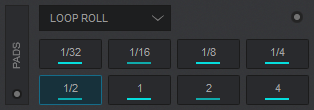
SLICER
Press the SLICER mode button to set the PADs to Slicer mode and automatically load the Slicer Pads page in VirtualDJ GUI
The 8 pads represent eight sequential beats—"Slices"—in the Beat Grid. The currently playing Slice is represented by the currently green lit pad. The light will move through the pads as it progresses through each eight-Slice phrase. Press a pad to repeat that Slice (hold it down if you want to keep looping it).
Once the Pad is released the track will continue to play from the position it would have been if the pad was never pressed.
Hold SHIFT and then use the Pads to repeat the memorized Slices (the Slices played/repeated last time)
Use the PARAMETER buttons to adjust the length of the Loop applied to the slice.
Hold SHIFT down and then use the PARAMETER buttons to adjust the step of the Slices
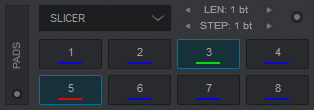
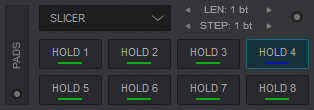
SAMPLER
Each one of the 8 pads triggers a sample from the selected Sampler Bank of VirtualDJ. If a bank has less than 9 samples, both sides of Mixars Primo will control the same samples. If a bank has more than 8 samples, the left side of Mixars Primo will control samples 1 to 8 and the right side samples 9 to 16.
Press the pads to trigger a sample. Depending on the selected trigger Pad mode, use SHIFT and the same pads to stop the sample.
Use PARAMETER buttons to select the Sampler Bank (previous/next).
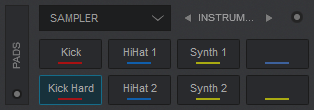
CUE LOOP
In this mode each one of the 8 pads assigns a Hot Cue Point or jumps the track to that Hot Cue Point, but in both cases, it also triggers a Loop at that point (momentary or toggle depending on the selected mode from the Page menu).
Hold SHIFT and then press a pad to stutter/jump to the Hotcue (loop will remain triggered)
Use PARAMETER buttons to half/double the size of the triggered Loop.
Hold SHIFT and then use PARAMETER buttons to select the On/Off (Toggle) or Hold (momentary) Loop trigger mode.
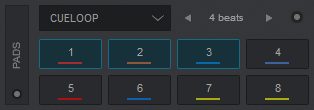
MANUAL LOOP
Hold down SHIFT and press the ROLL mode button to set the PADs to Manual Loop mode and automatically load the MANUAL LOOP page in VirtualDJ GUI.
Each one of the 8 pad offers a different loop function.
Use Pads 1 and 2 to set a Loop Entry (In) and a Loop Exit (Out) point for manual looping.
Use Pad 3 to turn off the Loop (if enabled) or trigger a Loop of the selected size in beats
Use Pad 4 to repeat the last triggered loop (Reloop)
Use Pads 5 and 6 to halve/double the size of the Loop.
Use Pads 7 and 8 to move the Loop (if enabled) forward/backwards by 1 beat
Hold down SHIFT and use ..
Pad 1 to set the Jogwheel to Loop In Adjust mode and use the Jogwheel to fine adjust the Loop In position
Pad 2 to set the Jogwheel to Loop Out Adjust mode and use the Jogwheel to fine adjust the Loop Out position
Pad 3 to set the Jogwheel to Loop Move Adjust mode and use the Jogwheel to fine move the Loop through the track.
Pad 4 to enable/disable Smart Loop. When Smart Loop is enabled (default status), using Loop In and Loop Out buttons to trigger a Manual Loop, will result of a seamless loop (track will stay on beat)
Pad 5 to enable/disable Loop Back mode. When Loop Back mode is enabled, and an Auto Loop is enabled, the current track's position will be considered as the Loop Out (Exit) point of the loop and the passed part of the track will be looped.
Pad 6 to enable/disable Quantize Loop mode. When enabled, the Loop In point of a Loop will be snapped to the nearest beat
Pad 7 and 8 to move the loop (if enabled) forward/backwards by the amount of the size of the loop.
Use the PARAMETER <> buttons to half/double the size of the Loop
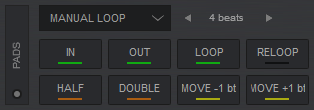
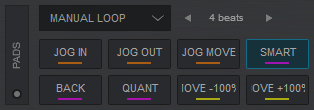
BEATJUMP
In this mode, each one of the Pads will jump the track backwards/forward by the amount of beats depending on the selected page/bank (from 1/8 beats to 32 bars)
Use the PAGE/PARAMETERS buttons to select the previous/next page with the desired Beats sizes
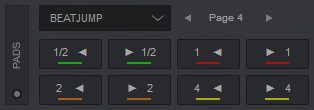
KEY CUE
Hold down SHIFT and press the SAMPLER mode button to set the PADs to KeyCue mode and automatically load the KeyCue Pads page in VirtualDJ GUI
In this mode, the Pads trigger a selected Hotcue point (or the Temporary Cue if none selected or not available) at a selected Key semitone (from -7 to +7).
8 different pages/banks are offered with various semitone values to use and a 0 value (reset key to it's original value) is always offered in all pages.
Hold SHIFT and then select a Hotcue for the Key pads to trigger. Each time a Pad is pressed, the track will jump to that Hotcue point and will also alter the Key of the track to the value designated by it assigned value.
Use the PARAMETER buttons to adjust the Key of the track without trigger a Hotcue.
Hold down SHIFT and use the PARAMETERS buttons to select a different bank with different key semitone values.
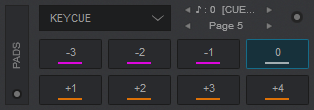
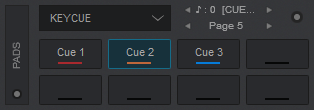
Read further details about Pads in the VirtualDJ 2020 manual
EFFECTS

Each one of the FX units offers 2 modes. The Single Effect mode that offers one effect slot but more parameters controls per effect, and the Multi Effects mode that offers 3 effect slots (to trigger more than 1 effect at the same time – chained effects).
The selection between those 2 modes is done by holding down SHIFT button and pressing the TAP (41) button down.
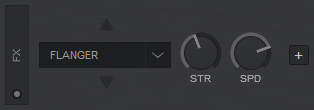
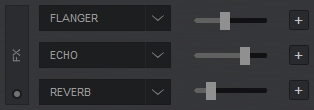
SINGLE EFFECT MODE
In this mode a single Effect is controlled with up to 6 Parameters and 2 Effect buttons. Only the first 2 Parameters are visible on the GUI. More Parameters and Effect buttons can be viewed in the FX GUI (opened from the + button on the GUI)
- FX1 knob: Controls the 1st effect parameter of the selected effect.
Hold down SHIFT and turn the knob to control the 4th effect parameter of the selected effect (if available). - FX2 knob: Controls the 2nd effect parameter of the selected effect (if available).
Hold down SHIFT and turn the knob to control the 5th effect parameter of the selected effect (if available). - FX3 knob: Controls the 3rd effect parameter of the selected effect (if available).
Hold down SHIFT and turn the knob to control the 6th effect parameter of the selected effect (if available) - FX1 ON: Enables/disables the selected effect.
Hold down SHIFT and press this button to open the current effect's GUI. - FX2 ON: Select the previous available effect.
Hold down SHIFT and press this button to enable/disable the 1st effect button of the selected effect (if available). - FX3 ON: Select the next available effect.
Hold down SHIFT and press this button to enable/disable the 2nd effect button of the selected effect (if available).
MULTI EFFECTS MODE
In this mode 3 different Effects can be applied and controlled with up to 2 Parameters for each FX slot. Only the first Parameter is visible on the GUI (and the 2nd Parameter while SHIFT is held down). More Parameters and Effect buttons can be viewed in the FX GUI (opened from the + button on the GUI)
- FX1 knob: Controls the 1st effect parameter of the selected effect of slot 1.
Hold down SHIFT and turn the knob to control the 2nd effect parameter of the selected effect of slot 1 (if available). - FX2 knob: Controls the 1st effect parameter of the selected effect of slot 2.
Hold down SHIFT and turn the knob to control the 2nd effect parameter of the selected effect of slot 2 (if available). - FX3 knob: Controls the 1st effect parameter of the selected effect of slot 3.
Hold down SHIFT and turn the knob to control the 2nd effect parameter of the selected effect of slot 3 (if available). - FX1 ON: Enable/disable the selected effect of slot 1.
Hold down SHIFT and press this button to select the next available effect for slot 1. - FX2 ON: Enable/disable the selected effect of slot 2.
Hold down SHIFT and press this button to select the next available effect for slot 2. - FX3 ON: Enable/disable the selected effect of slot 3.
Hold down SHIFT and press this button to select the next available effect for slot 3.
OTHER FX KEYS
- TAP. Press this button a few times to manually tap the tempo of the track.
Hold down SHIFT and then press this button to toggle between the Single and Multi Effect modes. - BEATS:
Turn: Adjust the Beats of Beat-aware Effects. Please note that this function will work only with effects that support it.
Hold down SHIFT and turn the knob on the left side of Mixars Primo to select a video transition. Turn the knob on the right side to select a Master Video Effect.
Push: Select 1 beat as the beat length of a Beat-aware effects.
Hold down SHIFT and push the knob on the left side of Mixars Primo to perform an automatic video transition from one deck to another. Push the knob on the right side to toggle the Master Video Effect on/off. - FX BANK 1: Press this button to recall the effects stored in FX Bank 1 on the effect slots of VirtualDJ.
Hold down SHIFT and press this button to save the current list of effects loaded on VirtualDJ effect slots on FX Bank 1. - FX BANK 2: Press this button to recall the effects stored in FX Bank 2 on the effect slots of VirtualDJ.
Hold down SHIFT and press this button to save the current list of effects loaded on VirtualDJ effect slots on FX Bank 2.
Front - Rear
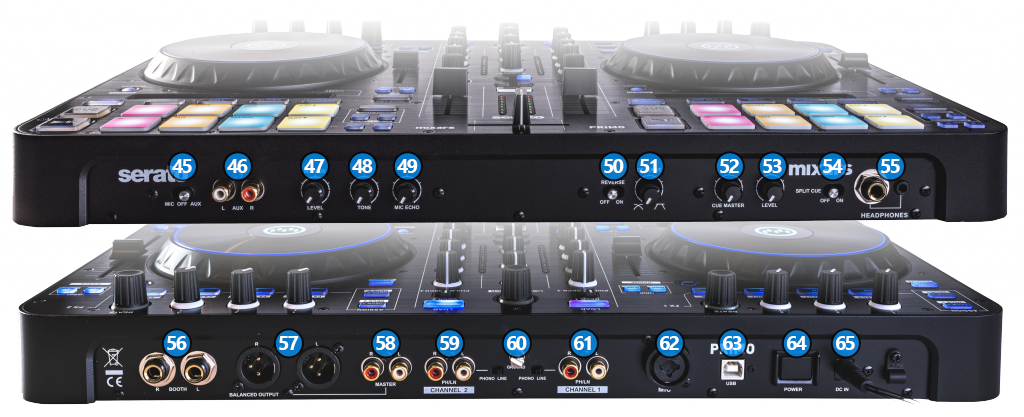
- MIC/AUX: Select if using the Mic (62) input (switch towards left) or the Aux (46) input (switch towards right). Center position turns the Mic/Aux Input off.
- AUX INPUT: Additional Aux input for connecting various Line signal sources, controlled via the MIC/AUX (47) knob.
- MIC/AUX LEVEL: Adjust the level of the Mic (62) or Aux (46) input.
- MIC/AUX TONE ADJUST: Adjust the tone of the Mic (62) or Aux (46) input.
- MIC ECHO: Adjust the Echo effect of the Mic input. (Please note that Echo Effect is a hardware effect and it cannot be adjusted/altered through VirtualDJ).
- CROSSFADER REVERSE: Reverses the Left with the Right Channel control on the Crossfader (1).
- CROSSFADER CURVE: Adjust the Crossfader curve from Hard (towards right) to Soft (towards left).
- HEADPHONES MIXING: Use this knob to blend in Headphones the audio signal from the Master Output and the Decks that are sent to Headphones Channel via the CUE/PFL buttons (3). When the knob is at the minimum position, only the Decks that have been selected with the CUE/PFL buttons (at the top panel) will be heard in Headphones. When the same knob is at the maximum (right) position, the signal from the Master Output will be heard in Headphones.
- HEADPHONES VOLUME: Adjust the headphones output volume.
- SPLIT CUE: If enabled, the headphones signal gets split: Master signal on one channel, and the enabled Cue signals selected via the CUE/PFL buttons (3) on the other channel.
- HEADPHONES CONNECTORS: Connect your headphones. Both sizes (3.5mm and 6.35mm ( 1⁄4 in)) are offered.
- BOOTH OUTPUT: Booth signal output (TRS – Balanced). The strength of the signal is controlled by BOOTH LEVEL knob (11) on the mixer section. Use it to connect your booth speakers, or an amp that needs different sound output level than master output.
- MASTER OUT1: Master signal output connectors (XLR – Balanced). Use this to connect on your pro grade amplifier or self-powered speakers.
- MASTER OUT2: Master signal output connectors (RCA – Unbalanced). Use it to connect with another mixer, or consumer grade amplifier.
- CH2 INPUT: Connect an analog source on CH2 of the Mixars Primo mixer. You can connect a turntable or a CD-Player. The input is selectable via the INPUT SELECT SWITCH (9) on the mixer section.
Please note that depending on whether you connect a CD player or a turntable you also need to adjust the phono/line switch for the input. - GND SCREW: Use it to screw your GND (ground) cable from turntables that provide it in order to eliminate GND static noise.
- CH1 INPUT: Connect an analog source on CH1 of the Mixars Primo mixer. You can connect a turntable or a CD-Player. The input is selectable via the INPUT SELECT SWITCH (9) on the mixer section.
Please note that depending on whether you connect a CD player or a turntable you also need to adjust the phono/line switch for the input. - MIC INPUT: Connect a mic on the Mixars Primo mixer. You can use XLR or Jack (TRS) connectors.
- USB CONNECTOR: Use a standard USB cable to connect Mixars Primo with your computer.
- POWER SWITCH: Turns on/off the power on the device. Please turn on the device only after doing and securing all connections on the back.
- DC INPUT: Connect the supplied PSU.